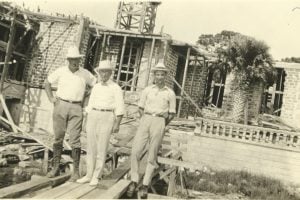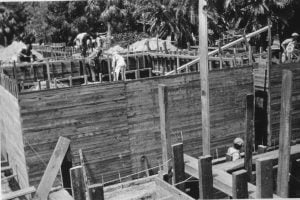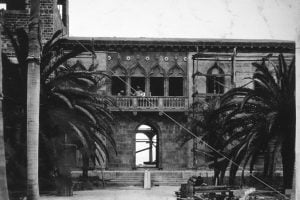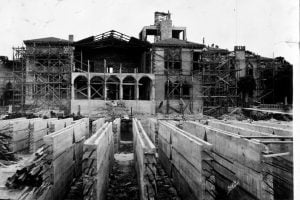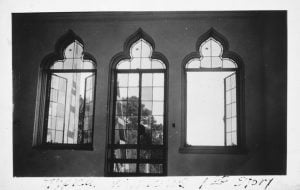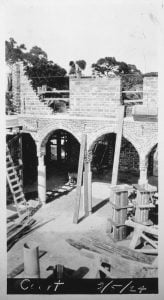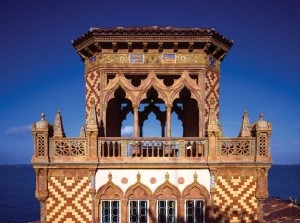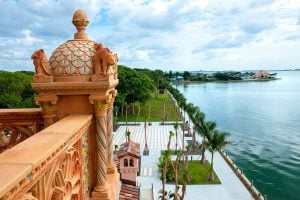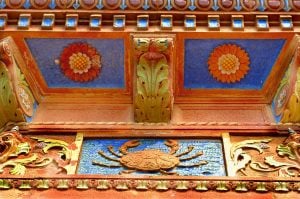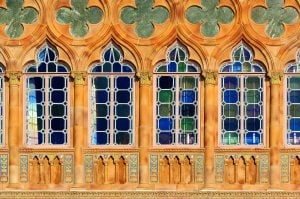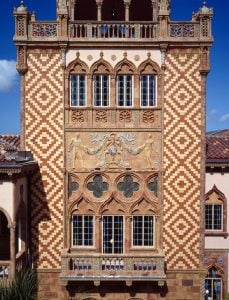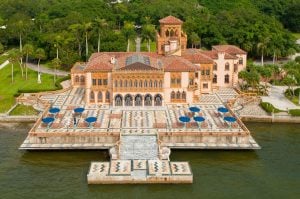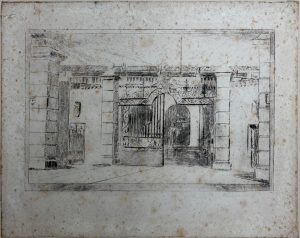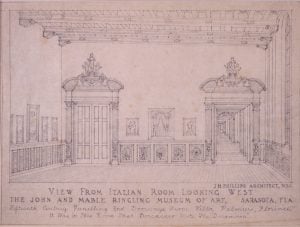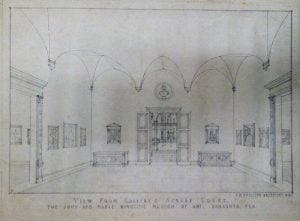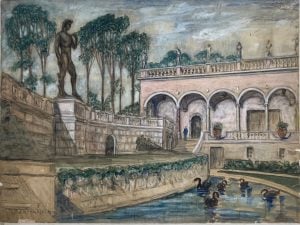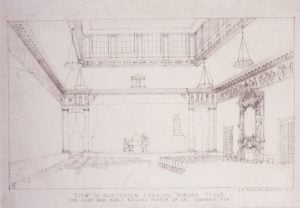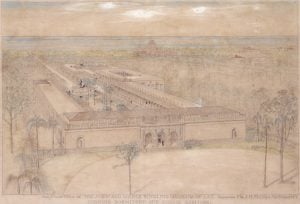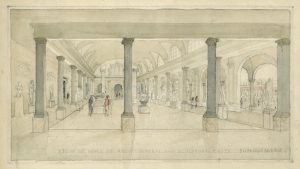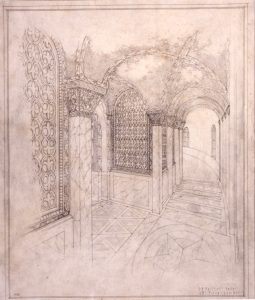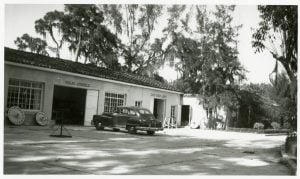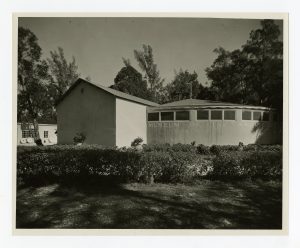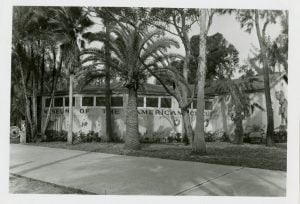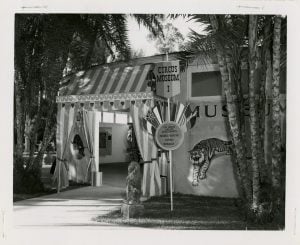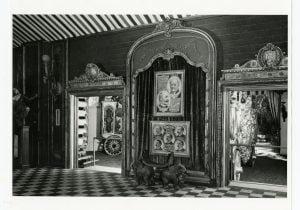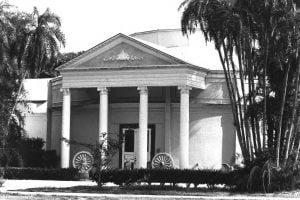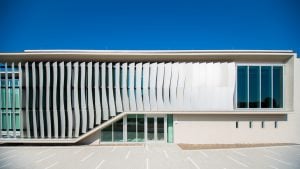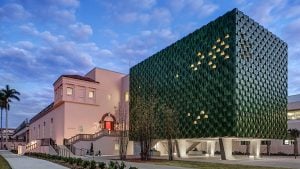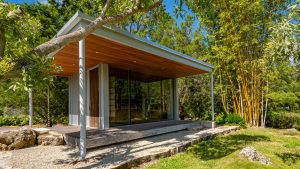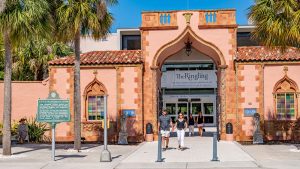The Ringling encompasses a wide range of architectural styles and structures. The earliest buildings on the estate are Ca’ d’Zan and the Museum of Art (completed in John Ringling’s lifetime) and the Historic Circus Galleries, opened by The Ringling’s first director.
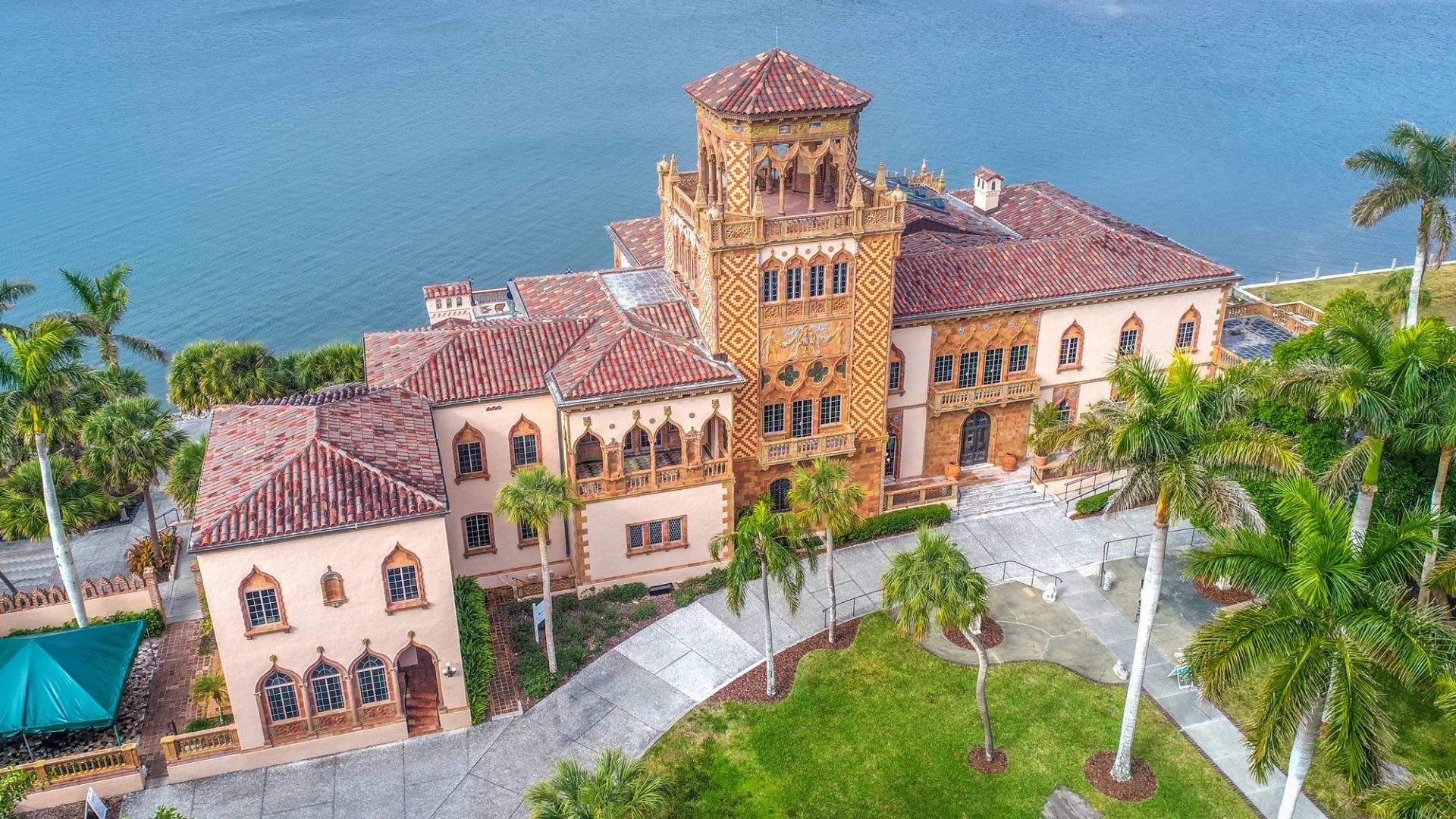
Ca’ d’Zan
In 1924, John and Mable Ringling commissioned renowned American architect Dwight James Baum (1886 – 1939) to design Ca’ d’Zan as their new winter residence. Completed in late 1926, this glamorous Mediterranean Revival style mansion represents a pastiche of historical influences combined with unique and whimsical design features. The mansion’s 36,000 square feet and 56 rooms include five guest suites, a service wing, a ballroom, a play room, a tap room, and a great hall. Ca’ d’Zan’s interior design was closely overseen by Mable Ringling and combines a range of European stylistic elements with attention to comfort and detail throughout.
Architect Dwight James Baum, who graduated from Syracuse University in 1909, quickly made a name for himself designing revival-style residences in the Riverdale area of the Bronx in New York City. In 1923, he became the youngest-ever recipient of the prestigious Gold Medal of the Architectural League of New York. Baum first visited Florida in 1922 and began working for John and Mable Ringling two years later. In addition to Ca’ d’Zan, many of Baum’s other Sarasota projects are still extant today, including the courthouse, the Sarasota Times Building, the Belle Haven apartments, the Presbyterian church downtown, and two homes on St. Armand’s Key. While working on Ca’ d’Zan, Baum was assisted by on-site architects Earl Purdy and Ralph Twitchell. Twitchell later established his own office in Sarasota and became a founding member of the Sarasota School of Architecture.
General contractor Owen Burns, who partnered with John Ringling on a number of ventures in Sarasota, oversaw construction on Ca’ d’Zan. Burns made significant contributions to the development of Sarasota, including paving its first streets, beginning a bank, and building housing subdivisions and a causeway to the keys.
Ca’ d’Zan’s Mediterranean Revival design elements include the barrel tile roof, asymmetrical façade, arches above doors and principal windows, and exterior stucco walls. Both the interior and exterior of Ca’ d’Zan feature custom-made terra cotta, some of which is glazed in vibrant colors. Much of the terra cotta is functional, forming balustrades, corbels, columns, and other support structures throughout the house. But it is also decorative, providing an array of design elements which range from the grotesque to the classicizing to the playful, as in the bats, owls, cats, and squirrels that surround the four turrets of the Belvedere Tower. The Belvedere Tower itself is five stories high, crowning the top of the mansion and providing 360-degree views of the Ringling property and Sarasota Bay. Another striking design feature of Ca’ d’Zan is the colored glass panes throughout all its windows, which create an enchanting effect in the sparkling marine light. The bayside terrace, 13,000 square feet in size, is made up of colorful marble laid out in a chevron pattern. A series of green marble quatrefoils and pointed arches along the façade pay homage to the Venetian Gothic influences (including landmarks such as the Doge’s Palace and Ca’ d’Oro) that helped inform the mansion’s design.
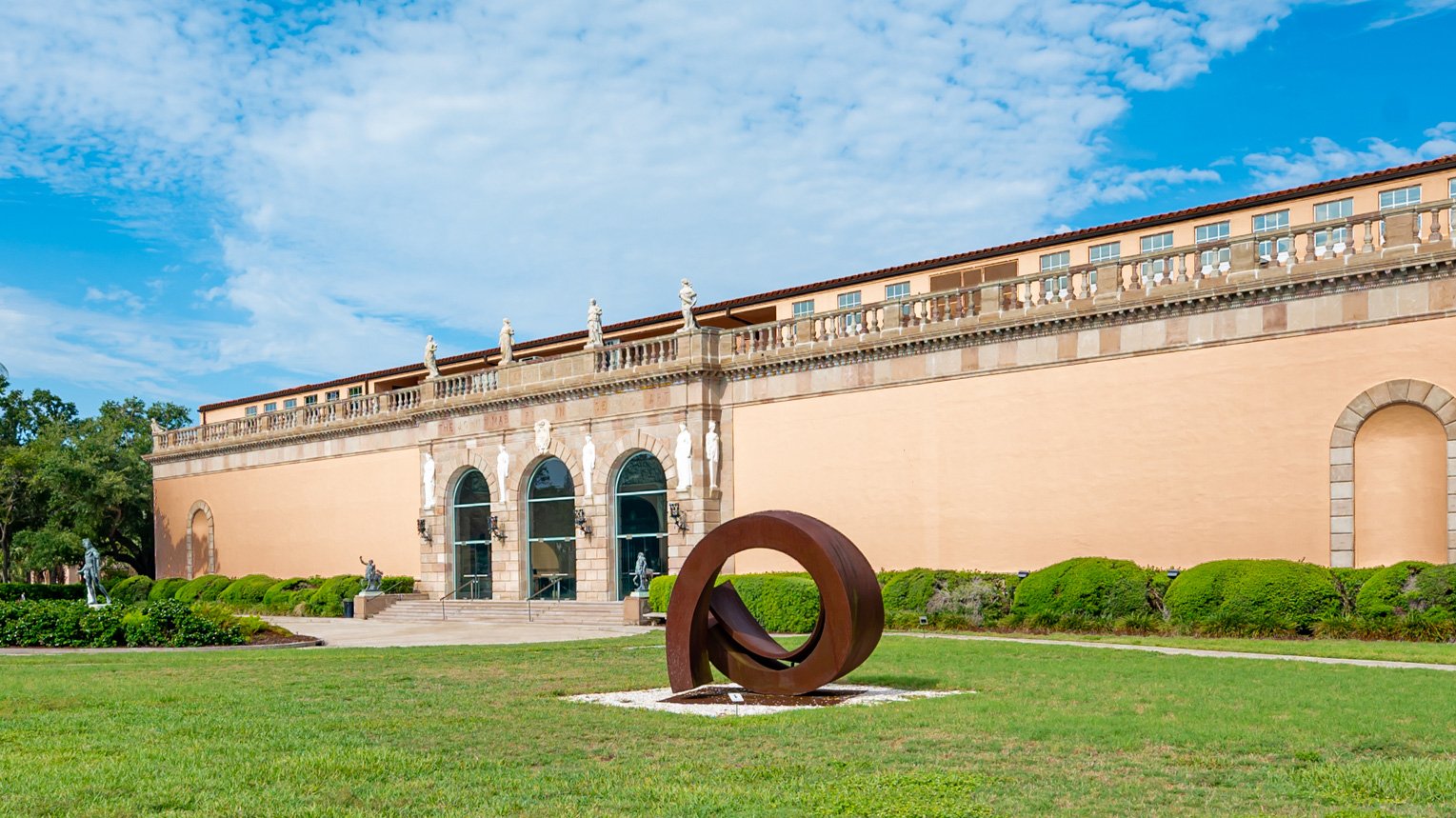
Museum of Art
The charter for The John and Mable Ringling Museum of Art was officially established in 1927. Construction of the building was completed in 1928, and the museum opened to the public for the first time in 1930. The pink Italianate structure is reminiscent of a Renaissance palazzo, with a U-shaped building and long loggias enclosing a courtyard. The two wings of the museum, which originally contained a total of twenty-one galleries, are connected by a marble bridge, upon which stands a bronze replica of Michelangelo’s David.
The Ringlings engaged notable architect John H. Phillips, known for his contributions to New York City’s Grand Central Terminal and the Metropolitan Museum of Art, in 1925. They first had Phillips design a guest cottage on their estate in 1926, using the same Italian-influenced style that he would ultimately use for the Museum of Art. The cottage, which still stands on the Ringling grounds, was used by the Ringlings’ yacht captain for many years and today serves as a private residence for visiting scholars and artists.
Phillips’ final design for the Museum of Art is not a direct copy of any one historical building, but the architect’s choice of a pink exterior, marble finishing, and rectangular U-shape are characteristic of many Italian Renaissance villas. The Museum of Art’s design exemplifies the desire of its founders to create a traditional structure that would convey culture, status, and longevity.
The Museum of Art incorporates an abundance of spolia—decorative fragments from older buildings—throughout its interior, exterior, and courtyard. Of note are the great wrought iron doors at the museum’s main entrance and the interiors of Galleries 19 and 20, which come from the Astor Mansion in New York City. When the mansion was demolished in 1926, John bought several significant elements and had them shipped to Sarasota to be fitted into his new museum.
Much of the other spolia that adorns the Museum of Art was purchased by John in Europe, originally intended for the Ritz Carlton hotel he was building in Sarasota. However, as plans for the museum were underway, John’s hotel venture failed, leaving many statues and decorative materials unused. John H. Phillips easily incorporated these materials into the museum’s design, placing sculptures on the roof in homage to Palladian and Baroque architectural precedent. Other elements left over from the Ritz Carlton became decoration in the museum’s interior and in its enclosed courtyard.
The courtyard also features bronze and marble copies of famous classical and Renaissance sculptures that John purchased from the Chiurazzi foundry in Naples. John intended to display these sculptures in a “Hall of Architecture and Sculpture Casts,” which was to be part of the museum’s planned art school. The art school’s classrooms and dormitories were designed as an extension to the north end of the museum, but the school was ultimately abandoned due to a lack of funds.
Another unrealized part of the original plan for the Museum of Art was a crypt, directly under the statue of David, that was to serve as John and Mable’s final resting place. This plan never came to full fruition (in part due to Mable’s early death in 1929 and John’s second marriage, which later ended in divorce) and today, John, Mable, and John’s sister Ida Ringling North are all buried on the northwest side of the property, behind what is known as the Secret Garden.
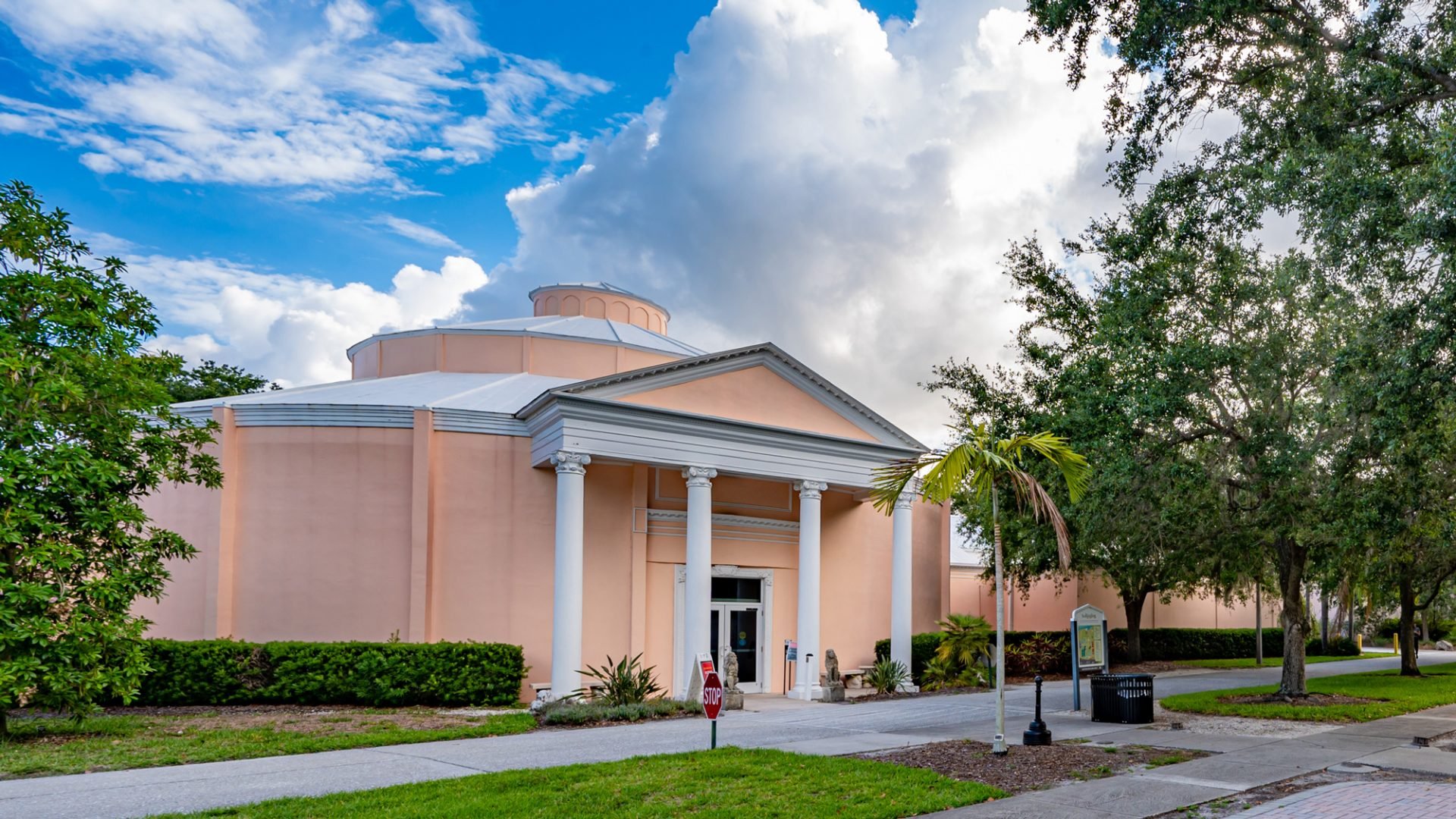
Circus Museum
In 1948, The Ringling’s inaugural director A. Everett ‘Chick’ Austin established the Circus Museum, the first museum in the country dedicated to the history of the American circus. The original Circus Museum building had once served as a garage for the Ringlings’ luxury automobiles, to which Austin added a circular rotunda suggestive of a circus tent. When the museum opened, the Sarasota Herald Tribune reported that it was “decorated with paneling in Louis XV style now painted red and gold. Tall windows of glass brick admit the light; huge mirrors reflect it. Mammoth frames make proscenium arches for low stages.”
The Ringling has continued to experience significant growth. Below are several notable additions to the landmark architecture on campus.
 Glass Pavilion
Glass Pavilion
Opened in 2018, the Kotler-Coville Glass Pavilion is the latest landmark work of innovative architecture on The Ringling’s campus. It was designed by the Tallahassee-based firm Architects Lewis + Whitlock, a regional firm known for its commitment to innovative and sustainable design. The 5,500-square-foot building’s wavy façade includes light-controlling aluminum fins inspired by the wind, water and sand—the main elements of glass. The architects describe their inspiration for Kotler-Coville Glass Pavilion as “the interaction of air, water, sand and the resulting ripples found in nature; both on the beach and in the shallow waters just offshore in the Gulf of Mexico.”
Center for Asian Art
The 25,000-square-foot Ting Tsung and Wei Fong Chao Center for Asian Art opened in 2016 as both an addition to, and gut renovation of, the 1966 extension to the original Museum of Art. Approximately 18,000 square feet of existing gallery space was converted to become the permanent home for The Ringling’s growing collection of Asian art. The new addition, at 7,500 square feet, included a new gallery space, a lecture hall for public programming, an object study room, and open storage.
Machado Silvetti is a leading architecture and urban design firm recognized for creating, revitalizing, and expanding distinctive buildings. To hear directly from the architects about their complex design and implementation process for the Chao Center for Asian Art, click here to be redirected to the Machado Silvetti’s article on the project.
The most striking feature of the Chao Center for Asian Art is the deep-green façade of the new pavilion addition, which consists of almost 3,000 individual glazed terra cotta tiles. Machado Silvetti collaborated with Boston Valley Terra Cotta to develop the color, form, and installation technique for the tiles, which give the structure the appearance of an undulating geometric cube. Inspiration for this unique design came in part from The Ringling’s history and diverse collection, including its jade objects, its lush Bayfront gardens, and the presence of terra cotta throughout the estate.
The pavilion addition is built above the ground, creating a plaza underneath which functions both as a formal entrance and as an outdoor event space. More practically, it also serves to elevate the gallery space out of a floodplain. The addition includes small windows that are integrated into geometry of the terra cotta exterior, appearing in what Machado Silvetti describes as “cloud-like” groupings throughout the structure.
Machado Silvetti describes the Chao Center for Asian Art as “both an anchor and hinge for the site, providing a circulation hub for the museum while serving as a monumental new point of entry,” further explaining that “the addition takes a deferential bow to the existing buildings by setting itself back from their courtyard frontage.” Whereas previous additions to the Museum of Art adopted the aesthetics of the original building, the Chao Center for Asian Art was always intended to serve as a boldly contemporary statement, providing a distinct break from the soft pink Italianate style of the rest of the museum.
 Tea House
Tea House
The Nancy L. and George R. Ellis Tea House was built on the museum grounds near the Chao Center for Asian Art. The Tea House marries the traditions of a historical tea house with the aesthetics of the Sarasota School of Architecture, which emphasize clean lines, direct forms, open spaces, contemporary materials, and a connection to the landscape. Materials used in the construction of a tea house are preferred in their raw state, hence its unfinished concrete and galvanized cladding. The interior and the overhang roof are made from reclaimed cypress from the Withlacoochee River, and the thresholds are made from local Australian Pine. The Tea house was designed by architect Glenn Darling, president and principal architect of Hall Darling Design Studio.
A tea house (chashitsu) is a contemplative space to enjoy nature and participate in an elegant ceremony designed to remove participants from the cares of daily life. The tea room has a low ceiling and no furniture: the guests and host sit on the floor. Guests enter the tea room through a small, square door called the nijiriguchi. It requires the guests to bow low to pass through, and symbolically separates the quiet interior from the busy world outside. There is a separate entrance for the host known as the sadōguchi, which allows access to the mizuya, the preparation space. A sunken hearth is located in the floor where the host heats the water.
In the Japanese ceremony, referred to as chanoyu, a host serves tea to the guests, who have the opportunity to watch the tea being made. The Japanese version of tea for these ceremonies begins with matcha, a powder of ground tea leaves. The ceremony’s special utensils include a tea scoop (chashaku) for removing loose tea leaves from a tea storage vessel, a bamboo whisk (chasen) for mixing the tea powder with water until smooth, a water jar, a tea caddy, and tea bowls. Special utensils and bowls are designed to assist in the appreciation of the natural world. Tea bowls may have a rustic appearance, irregular asymmetrical shapes, and uneven glazes.
Beyond its basic format, each tea ceremony is unique because the host designs it to impart a symbolic message to share with guests. Guests are encouraged to think along the lines of the themes suggested by the host through contemplating the selection of flowers, utensils, and teas provided in the tea house.
 Visitors Pavilion
Visitors Pavilion
The John M. McKay Visitors Pavilion opened in 2006, becoming the new entry point for museum guests. Before arriving in the McKay Visitors Pavilion, visitors first pass through the historic 1926 terra cotta and wrought iron gatehouse that originally served as the entrance to John and Mable Ringling’s private estate. Constructed just behind the gatehouse, the McKay Visitors Pavilion is made of pre-cast concrete mixed with coquina shell. Its slightly pinkish tinge is in keeping with other buildings on The Ringling’s campus, creating a contemporary yet simple style with Tuscan influences. The McKay Visitors Pavilion was designed by Yann Weymouth, noted for his role as chief of design on I.M. Pei’s Grand Louvre Project and for The Dalí Museum in St. Petersburg, Florida.
